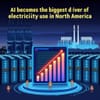A new energy report from DNV shows that AI‑driven data centers are now the fastest‑growing source of power demand in North America. Companies like Meta, Amazon, Google and OpenAI are building massive facilities packed with thousands of high‑performance computers to train models and serve tools such as ChatGPT, Gemini and Sora. By 2040, AI‑focused data centers alone will account for roughly 12 % of the region’s electricity consumption, a share that could make AI the single largest driver of power use over the next five years .
The surge is already reshaping the grid. Huatai Securities estimates that U.S. electricity demand will grow 2.3 % in 2025 and 3.0 % in 2026, with AI data centers adding 6‑13 GW of extra load each year—far outpacing historical growth rates. This rapid expansion has created a projected power shortfall of 18‑27 GW by the end of 2026, prompting utilities and policymakers to consider large‑scale energy‑storage solutions and even longer‑term transmission upgrades that could cost hundreds of billions of dollars .
Despite the exponential rise, analysts expect the growth curve to flatten over time. DNV’s model predicts that AI’s initial explosive demand will transition to a more linear increase as efficiency gains and new technologies come online. Even so, AI’s power needs will remain a smaller slice of total electricity use than electric‑vehicle charging and space‑cooling by 2040, underscoring the need for careful planning and investment in the grid .
The policy landscape is also shifting. The Trump administration’s “America’s AI Action Plan” pushes for rapid data‑center construction, downplaying regulatory hurdles, while lawmakers in several states are drafting new rate structures to protect residential customers from the cost impacts of large‑load projects. Balancing innovation with grid reliability and affordability will be central to how North America navigates this AI‑driven energy transformation .


